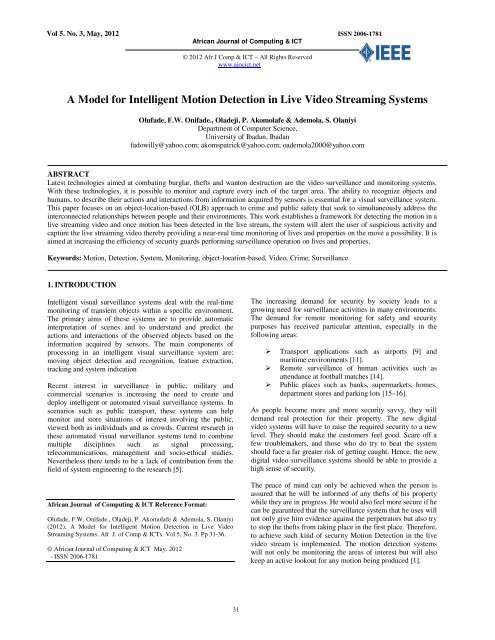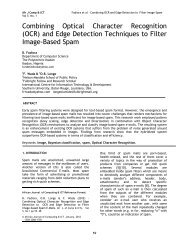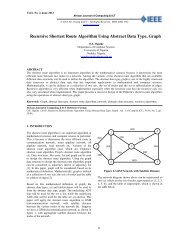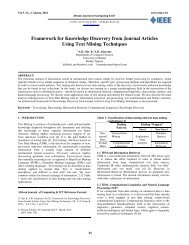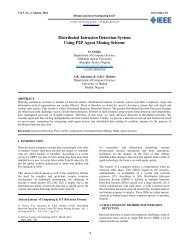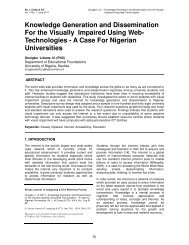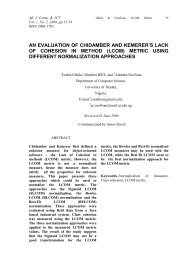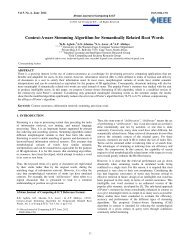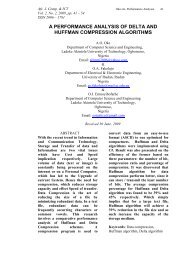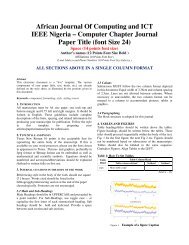A Model for Intelligent Motion Detection in Live Video Streaming ...
A Model for Intelligent Motion Detection in Live Video Streaming ...
A Model for Intelligent Motion Detection in Live Video Streaming ...
You also want an ePaper? Increase the reach of your titles
YUMPU automatically turns print PDFs into web optimized ePapers that Google loves.
Vol 5. No. 3, May, 2012 ISSN 2006-1781<br />
African Journal of Comput<strong>in</strong>g & ICT<br />
© 2012 Afr J Comp & ICT – All Rights Reserved<br />
www.ajocict.net<br />
A <strong>Model</strong> <strong>for</strong> <strong>Intelligent</strong> <strong>Motion</strong> <strong>Detection</strong> <strong>in</strong> <strong>Live</strong> <strong>Video</strong> Stream<strong>in</strong>g Systems<br />
Olufade, F.W. Onifade., Oladeji, P. Akomolafe & Ademola, S. Olaniyi<br />
Department of Computer Science,<br />
University of Ibadan, Ibadan<br />
fadowilly@yahoo.com; akomspatrick@yahoo.com; oademola2000@yahoo.com<br />
ABSTRACT<br />
Latest technologies aimed at combat<strong>in</strong>g burglar, thefts and wanton destruction are the video surveillance and monitor<strong>in</strong>g systems.<br />
With these technologies, it is possible to monitor and capture every <strong>in</strong>ch of the target area. The ability to recognize objects and<br />
humans, to describe their actions and <strong>in</strong>teractions from <strong>in</strong><strong>for</strong>mation acquired by sensors is essential <strong>for</strong> a visual surveillance system.<br />
This paper focuses on an object-location-based (OLB) approach to crime and public safety that seek to simultaneously address the<br />
<strong>in</strong>terconnected relationships between people and their environments. This work establishes a framework <strong>for</strong> detect<strong>in</strong>g the motion <strong>in</strong> a<br />
live stream<strong>in</strong>g video and once motion has been detected <strong>in</strong> the live stream, the system will alert the user of suspicious activity and<br />
capture the live stream<strong>in</strong>g video thereby provid<strong>in</strong>g a near-real time monitor<strong>in</strong>g of lives and properties on the move a possibility. It is<br />
aimed at <strong>in</strong>creas<strong>in</strong>g the efficiency of security guards per<strong>for</strong>m<strong>in</strong>g surveillance operation on lives and properties.<br />
Keywords: <strong>Motion</strong>, <strong>Detection</strong>, System, Monitor<strong>in</strong>g, object-location-based, <strong>Video</strong>, Crime, Surveillance.<br />
1. INTRODUCTION<br />
<strong>Intelligent</strong> visual surveillance systems deal with the real-time<br />
monitor<strong>in</strong>g of transient objects with<strong>in</strong> a specific environment.<br />
The primary aims of these systems are to provide automatic<br />
<strong>in</strong>terpretation of scenes and to understand and predict the<br />
actions and <strong>in</strong>teractions of the observed objects based on the<br />
<strong>in</strong><strong>for</strong>mation acquired by sensors. The ma<strong>in</strong> components of<br />
process<strong>in</strong>g <strong>in</strong> an <strong>in</strong>telligent visual surveillance system are:<br />
mov<strong>in</strong>g object detection and recognition, feature extraction,<br />
track<strong>in</strong>g and system <strong>in</strong>dication<br />
Recent <strong>in</strong>terest <strong>in</strong> surveillance <strong>in</strong> public, military and<br />
commercial scenarios is <strong>in</strong>creas<strong>in</strong>g the need to create and<br />
deploy <strong>in</strong>telligent or automated visual surveillance systems. In<br />
scenarios such as public transport, these systems can help<br />
monitor and store situations of <strong>in</strong>terest <strong>in</strong>volv<strong>in</strong>g the public,<br />
viewed both as <strong>in</strong>dividuals and as crowds. Current research <strong>in</strong><br />
these automated visual surveillance systems tend to comb<strong>in</strong>e<br />
multiple discipl<strong>in</strong>es such as signal process<strong>in</strong>g,<br />
telecommunications, management and socio-ethical studies.<br />
Nevertheless there tends to be a lack of contribution from the<br />
field of system eng<strong>in</strong>eer<strong>in</strong>g to the research [5].<br />
African Journal of Comput<strong>in</strong>g & ICT Reference Format:<br />
Olufade, F.W. Onifade., Oladeji, P. Akomolafe & Ademola, S. Olaniyi<br />
(2012). A <strong>Model</strong> <strong>for</strong> <strong>Intelligent</strong> <strong>Motion</strong> <strong>Detection</strong> <strong>in</strong> <strong>Live</strong> <strong>Video</strong><br />
Stream<strong>in</strong>g Systems. Afr J. of Comp & ICTs. Vol 5, No. 3. Pp 31-36.<br />
© African Journal of Comput<strong>in</strong>g & ICT May, 2012<br />
- ISSN 2006-1781<br />
The <strong>in</strong>creas<strong>in</strong>g demand <strong>for</strong> security by society leads to a<br />
grow<strong>in</strong>g need <strong>for</strong> surveillance activities <strong>in</strong> many environments.<br />
The demand <strong>for</strong> remote monitor<strong>in</strong>g <strong>for</strong> safety and security<br />
purposes has received particular attention, especially <strong>in</strong> the<br />
follow<strong>in</strong>g areas:<br />
<br />
<br />
<br />
Transport applications such as airports [9] and<br />
maritime environments [11].<br />
Remote surveillance of human activities such as<br />
attendance at football matches [14].<br />
Public places such as banks, supermarkets, homes,<br />
department stores and park<strong>in</strong>g lots [15–16].<br />
As people become more and more security savvy, they will<br />
demand real protection <strong>for</strong> their property. The new digital<br />
video systems will have to raise the required security to a new<br />
level. They should make the customers feel good. Scare off a<br />
few troublemakers, and those who do try to beat the system<br />
should face a far greater risk of gett<strong>in</strong>g caught. Hence, the new<br />
digital video surveillance systems should be able to provide a<br />
high sense of security.<br />
The peace of m<strong>in</strong>d can only be achieved when the person is<br />
assured that he will be <strong>in</strong><strong>for</strong>med of any thefts of his property<br />
while they are <strong>in</strong> progress. He would also feel more secure if he<br />
can be guaranteed that the surveillance system that he uses will<br />
not only give him evidence aga<strong>in</strong>st the perpetrators but also try<br />
to stop the thefts from tak<strong>in</strong>g place <strong>in</strong> the first place. There<strong>for</strong>e,<br />
to achieve such k<strong>in</strong>d of security <strong>Motion</strong> <strong>Detection</strong> <strong>in</strong> the live<br />
video stream is implemented. The motion detection systems<br />
will not only be monitor<strong>in</strong>g the areas of <strong>in</strong>terest but will also<br />
keep an active lookout <strong>for</strong> any motion be<strong>in</strong>g produced [1].<br />
31
Vol 5. No. 3, May, 2012 ISSN 2006-1781<br />
African Journal of Comput<strong>in</strong>g & ICT<br />
© 2012 Afr J Comp & ICT – All Rights Reserved<br />
www.ajocict.net<br />
The rest of this work is as follows: <strong>in</strong> section II, we give related<br />
works, while section III has the model development and<br />
methodology. Section IV presents the result discussion and the<br />
work is concluded <strong>in</strong> section V.<br />
2. RELATED WORKS<br />
The technological evolution of video-based surveillance<br />
systems started with analogue CCTV systems. These systems<br />
consist of a number of cameras located <strong>in</strong> a multiple remote<br />
location and connected to a set of monitors, usually placed <strong>in</strong> a<br />
s<strong>in</strong>gle control room, via switches (a video matrix). <strong>Video</strong><br />
surveillance began with simple closed circuit television<br />
monitor<strong>in</strong>g (CCTV). As early as 1965, there were press reports<br />
<strong>in</strong> various countries across the world suggest<strong>in</strong>g police use of<br />
surveillance cameras <strong>in</strong> public places. When video cassette<br />
recorders hit the market, video surveillance became really<br />
popular.<br />
Analog technology us<strong>in</strong>g taped video-cassette record<strong>in</strong>gs meant<br />
surveillance could be preserved on tape as evidence. A<br />
complete analog video-surveillance system consisted of a<br />
camera, monitor, and VCR. The old tube camera was only<br />
useful <strong>in</strong> daylight, and the VCR could only store eight hours of<br />
footage at best. The drawback was that after a while, owners<br />
and employees of such a system would become complacent and<br />
not change the tapes daily or the tapes would wear out after<br />
months of be<strong>in</strong>g re-used. There was also the problem of<br />
record<strong>in</strong>g at night or <strong>in</strong> low light.<br />
While the concept was good, the technology hadn’t yet peaked.<br />
The next step was the Charged Coupled Device camera (CCD),<br />
which used microchip computer technology. In the 1990’s<br />
video surveillance made great strides <strong>in</strong> practicality by the<br />
<strong>in</strong>troduction of digital multiplex<strong>in</strong>g. When digital multiplexer<br />
units became af<strong>for</strong>dable, it revolutionized the surveillance<br />
<strong>in</strong>dustry by enabl<strong>in</strong>g record<strong>in</strong>g on several cameras at once<br />
(more than a dozen at time <strong>in</strong> most cases) [1].<br />
Three key factors brought on the popular use of the digital<br />
video recorder. They are:<br />
The advancement <strong>in</strong> compression capability,<br />
allow<strong>in</strong>g more <strong>in</strong><strong>for</strong>mation to be stored on a hard<br />
drive. (Round-the-clock surveillance produces a lot<br />
of <strong>in</strong><strong>for</strong>mation.)<br />
The cost of a hard drive, which has dropped<br />
dramatically <strong>in</strong> recent years.<br />
The storage capacity of a hard drive, which has<br />
<strong>in</strong>creased dramatically <strong>in</strong> recent years.<br />
Digital video surveillance made complete sense as the price of<br />
digital record<strong>in</strong>g dropped with the computer revolution. Rather<br />
than chang<strong>in</strong>g tapes daily, the user could reliably record a<br />
month's worth of surveillance on hard drive. The images<br />
recorded digitally were much clearer than the often gra<strong>in</strong>y<br />
images recorded with analog that recognition was immediately<br />
improved <strong>for</strong> identification purposes.<br />
Digitally stored images can also be enhanced <strong>in</strong> various ways<br />
(add light, change colors, reverse black and white) to make<br />
crucial determ<strong>in</strong>ations. With videotape, what you see is what<br />
you get. It’s aga<strong>in</strong>st this backdrop that this research is carried<br />
out to br<strong>in</strong>g <strong>in</strong>to play a mobile monitor<strong>in</strong>g of lives and<br />
properties of subscribers of the proposed system.<br />
Some of the approaches <strong>for</strong> mov<strong>in</strong>g objects detection use<br />
simple <strong>in</strong>tensity comparison to reference images so that the<br />
values above a given threshold identify the pixels of mov<strong>in</strong>g<br />
objects [8]. A large class of approaches is based on appropriate<br />
statistics of colour or gray level values over time at each pixel<br />
location. (e.g. the segmentation by background subtraction<br />
[10], eigenbackground subtraction [12], etc). Other models<br />
used a statistical model of the background <strong>in</strong>stead of a<br />
reference image [13].<br />
3. MODEL DESCRIPTION<br />
A model description of our system is shown below. The<br />
webcam captures the live video feed <strong>in</strong> real time. This live feed<br />
is plugged <strong>in</strong>to the server which redisplays the orig<strong>in</strong>al live<br />
feed <strong>in</strong> real-time, whilst do<strong>in</strong>g image process<strong>in</strong>g <strong>in</strong> the<br />
backend.<br />
Hierarchically, the operational system model can be described<br />
<strong>in</strong> the follow<strong>in</strong>g ways:<br />
Captur<strong>in</strong>g the live video feed through a webcam (motion<br />
sensor equipment): To detect motion we first have to capture<br />
live video frames of the area to be monitored and kept under<br />
surveillance. This is done by us<strong>in</strong>g a web cam which<br />
cont<strong>in</strong>uously provides a sequence of video frames <strong>in</strong> a<br />
specified speed of FPS (frames per second).<br />
Compar<strong>in</strong>g the current frames captured with previous<br />
frames to detect motion: For check<strong>in</strong>g whether any motion is<br />
present <strong>in</strong> the live video feed, we compare the live video<br />
frames be<strong>in</strong>g provided by the web cam with each other so that<br />
we can detect changes <strong>in</strong> these frames and hence predict the<br />
occurrence of some motion.<br />
32
Vol 5. No. 3, May, 2012 ISSN 2006-1781<br />
African Journal of Comput<strong>in</strong>g & ICT<br />
© 2012 Afr J Comp & ICT – All Rights Reserved<br />
www.ajocict.net<br />
Figure 1: Basic System <strong>Model</strong><br />
Stor<strong>in</strong>g the frames on the memory if motion is<br />
detected: If motion is detected, the video recorder <strong>in</strong><br />
commence record<strong>in</strong>g such motion so that the user can<br />
view it <strong>in</strong> the near future. This also helps the user <strong>in</strong><br />
provid<strong>in</strong>g a legal proof of some <strong>in</strong>appropriate activity<br />
s<strong>in</strong>ce a video coverage can be used as a proof <strong>in</strong> the<br />
court of law.<br />
Indicat<strong>in</strong>g through an alarm when the motion is<br />
detected: This is the novel part of the development. We<br />
believed there should be provision <strong>for</strong> real-time<br />
monitor<strong>in</strong>g of such live feed <strong>in</strong> other to <strong>in</strong>timate the user<br />
of any impend<strong>in</strong>g danger. To this end, once an <strong>in</strong>trusion<br />
is detected by the system, the <strong>in</strong>dication system which is<br />
<strong>in</strong>cluded <strong>in</strong> the software will trigger an alert which could<br />
be <strong>in</strong> <strong>for</strong>m of an SMS or MMS sent to the user with<br />
pictures of sample threat. This helps <strong>in</strong> prevent<strong>in</strong>g any<br />
k<strong>in</strong>d of breach of security at that moment of time.<br />
3.1 System Architecture<br />
The detection of motion essentially requires the user to<br />
per<strong>for</strong>m two major steps. They are: acquisition of the<br />
video data <strong>in</strong> which the motion is to be detected and the<br />
later step is to actually device an algorithm by which the<br />
motion will be detected. The video stream is stored or<br />
acquired as a series of frames occurr<strong>in</strong>g <strong>in</strong> an ordered<br />
sequence one after the other. Algorithm <strong>for</strong> detection<br />
becomes imperative because other factors/mov<strong>in</strong>g<br />
objects like dogs and other domestic animals/pets might<br />
trigger unnecessary movement with the set space. The<br />
system is developed <strong>in</strong> such a way that once a snap-shot<br />
is taken, it is compared to exist<strong>in</strong>g, predef<strong>in</strong>ed images <strong>in</strong><br />
the database <strong>for</strong> validation be<strong>for</strong>e further actions. This<br />
elim<strong>in</strong>ate the false-positive response that could result<br />
from pets but take <strong>in</strong>to cognizance the issue of<br />
“creep<strong>in</strong>g-human” with a bid to disguise or fool the<br />
system. Keep<strong>in</strong>g the work objective <strong>in</strong> m<strong>in</strong>d, we present<br />
the basic system architecture as shown below.<br />
33
Vol 5. No. 3, May, 2012 ISSN 2006-1781<br />
African Journal of Comput<strong>in</strong>g & ICT<br />
© 2012 Afr J Comp & ICT – All Rights Reserved<br />
www.ajocict.net<br />
Object<br />
<strong>Detection</strong><br />
Object<br />
Capture<br />
Image process<strong>in</strong>g<br />
and analysis<br />
Feature<br />
Extraction<br />
Object<br />
Recognition<br />
Track<strong>in</strong>g<br />
Stor<strong>in</strong>g<br />
System<br />
Indication<br />
Figure 2: Basic system architecture of our system<br />
4. DISCUSSION<br />
The system architecture which we developed was<br />
adapted from [6], describes how the system component<br />
<strong>in</strong>teracts and work together to achieve the overall system<br />
goals. It describes the system operation, what each<br />
component of the system does and what <strong>in</strong><strong>for</strong>mation is<br />
exchanged. The system is <strong>in</strong>itialized to take a snapshot<br />
of an image which is referred to as Old. With the<br />
system’s <strong>in</strong>built timer, the next image taken will be<br />
referred to as Current. If there exists a difference <strong>in</strong> the<br />
Old and Current images’ RGB values, the motion is said<br />
to occur which is detected by the sensors.<br />
Here motion detection algorithm is based on frame<br />
difference calculation <strong>in</strong> terms of RGB values and<br />
brightness threshold values stored <strong>in</strong> byte arrays. The<br />
algorithm compares two consecutive frames Old and<br />
Current, pixel by pixel to generate a difference value. If<br />
the difference value is greater than a fixed value<br />
(randomly taken), then motion is detected. Else if, there<br />
is no difference between previous and current frame’s<br />
byte arrays then Old is set to Current. The process<br />
repeats accord<strong>in</strong>g to the program’s set timer.<br />
34
Vol 5. No. 3, May, 2012 ISSN 2006-1781<br />
African Journal of Comput<strong>in</strong>g & ICT<br />
© 2012 Afr J Comp & ICT – All Rights Reserved<br />
www.ajocict.net<br />
Table 1: System Architecture Description<br />
S/N FEATURE DESCRIPTION<br />
1 Object <strong>Detection</strong>/capture A digital image is produced by a security camera<br />
2<br />
3<br />
4<br />
Image process<strong>in</strong>g and<br />
analysis<br />
Feature extraction<br />
Object Recognition<br />
Re-sampl<strong>in</strong>g <strong>in</strong> order to assure that the image coord<strong>in</strong>ate<br />
system is correct.<br />
Noise reduction <strong>in</strong> order to assure that sensor noise does<br />
not <strong>in</strong>troduce false <strong>in</strong><strong>for</strong>mation.<br />
Frame Differenc<strong>in</strong>g with b<strong>in</strong>ary threshold<strong>in</strong>g to remove<br />
stationary objects.<br />
Regions of <strong>in</strong>terest (ROI) such as blobs.<br />
<strong>Motion</strong> History Image (MHI) to store blobs movement<br />
pattern.<br />
MHI is stored <strong>in</strong> a cyclic buffer - a s<strong>in</strong>gle, fixed-sized array<br />
as if it were connected end-to-end<br />
5 Object track<strong>in</strong>g Us<strong>in</strong>g the MHI extracted from the image to determ<strong>in</strong>e the<br />
movement between images.<br />
Below, we discuss the methodology by elaborat<strong>in</strong>g on<br />
the follow<strong>in</strong>g key techniques used <strong>in</strong> develop<strong>in</strong>g the<br />
system:<br />
On captur<strong>in</strong>g a frame, gray scal<strong>in</strong>g is used to convert<br />
colour images to its grayscale equivalent. The grayscale<br />
image shows the effective brightness or lum<strong>in</strong>ance of<br />
the colour image. The conversion, to a shade of grey<br />
from a colour image, is established by calculat<strong>in</strong>g the<br />
effective brightness or lum<strong>in</strong>ance of the colour. This<br />
value is then used to create the shade of grey that<br />
corresponds to the desired brightness. Frame difference<br />
is used when the still part of an image needs to be<br />
separated from the mov<strong>in</strong>g part of the image. Dur<strong>in</strong>g the<br />
frame differenc<strong>in</strong>g process a b<strong>in</strong>ary threshold value<br />
needs to be used to get rid of unwanted noise whilst<br />
preserv<strong>in</strong>g the <strong>for</strong>eground. Sett<strong>in</strong>g the threshold to the<br />
correct value is important so that we get acceptable<br />
results <strong>in</strong> blob track<strong>in</strong>g.<br />
The motion history image is the f<strong>in</strong>al component <strong>for</strong><br />
blob track<strong>in</strong>g. This method focuses on accumulat<strong>in</strong>g and<br />
recogniz<strong>in</strong>g entire object patterns rather than focus<strong>in</strong>g<br />
on detailed features. The advantages of this approach are<br />
the low use of memory and blaz<strong>in</strong>gly fast yet descriptive<br />
representation of captur<strong>in</strong>g motion on a per blob basis. It<br />
has coord<strong>in</strong>ates that can be used to measure the width<br />
and the height of the blob component.<br />
The relative angle at which the blob is travers<strong>in</strong>g is also<br />
measured. The MHI is created by layer<strong>in</strong>g images over<br />
successive image regions. This system can be embedded<br />
<strong>in</strong> home monitor<strong>in</strong>g systems which are ga<strong>in</strong><strong>in</strong>g <strong>in</strong>terest<br />
<strong>in</strong> recent years. This system can be used to detect motion<br />
<strong>in</strong> target areas. It prevents users from mak<strong>in</strong>g blunders<br />
which can arise as a result of miss<strong>in</strong>g footage when<br />
monitor<strong>in</strong>g several screens. It can also be used to<br />
prevent car hijack<strong>in</strong>g <strong>in</strong> various park<strong>in</strong>g stations. Once<br />
unusual movement is detected by the system, the system<br />
<strong>in</strong>dicator triggers an alarm. Such monitor<strong>in</strong>g keeps the<br />
heart of users at rest know<strong>in</strong>g full well that their<br />
properties are secured. The video recorder commences<br />
record<strong>in</strong>g once motion has been detected. This recorded<br />
video can be used an evidence <strong>in</strong> the court of law.<br />
5. CONCLUSION<br />
This paper presents the framework <strong>for</strong> the design of a<br />
video monitor<strong>in</strong>g and detection system. This system<br />
ma<strong>in</strong>ly provides an efficient method <strong>for</strong> surveillance<br />
purposes and is aimed to be highly beneficial to an<br />
<strong>in</strong>dividual or organization. As a future work, extended<br />
ef<strong>for</strong>ts are be<strong>in</strong>g made to enhance the security<br />
provisions. Works can also be done to ensure that the<br />
video coverage is saved on multiple storage devices <strong>in</strong><br />
real time, <strong>in</strong> case of damage. This will serve as a<br />
backup.<br />
REFERENCES<br />
[1] Asif Ansari1, T.C.Manjunath, C.Ardil (2008):<br />
Implementation of a <strong>Motion</strong> <strong>Detection</strong><br />
System; World Academy of Science,<br />
Eng<strong>in</strong>eer<strong>in</strong>g and Technology<br />
35
Vol 5. No. 3, May, 2012 ISSN 2006-1781<br />
African Journal of Comput<strong>in</strong>g & ICT<br />
© 2012 Afr J Comp & ICT – All Rights Reserved<br />
www.ajocict.net<br />
[2] B<strong>in</strong>g-Fei Wu, Hs<strong>in</strong>-Yuan Peng, Chao-Jung<br />
Chen (2006): A Practical Home Security<br />
System via Mobile Phones; Department of<br />
Electrical and Control Eng<strong>in</strong>eer<strong>in</strong>g National<br />
Chaio-Tung University<br />
[3] Boop Button (2011): Terrorist 'pre-crime'<br />
detector field tested <strong>in</strong> United States.Screen<strong>in</strong>g<br />
system aims to p<strong>in</strong>po<strong>in</strong>t passengers with<br />
malicious <strong>in</strong>tentions [onl<strong>in</strong>e],<br />
http://www.nature.com/news/2011/110527/ful<br />
l/news.2011.323.html<br />
[4] Dane Brown, Mr James Connan, Mr Mehrdad<br />
Ghaziasgar (2010): Suspicious Activity<br />
<strong>Detection</strong>; m<strong>in</strong>i-thesis Department of<br />
Computer Science; University of the Western<br />
Cape<br />
[5] M. Valera, S.A. Velast<strong>in</strong> (2005): <strong>Intelligent</strong><br />
distributed surveillance systems: a review IEE<br />
Proceed<strong>in</strong>gs onl<strong>in</strong>e no. 20041147. Digital<br />
Imag<strong>in</strong>g Research Centre, School of<br />
Comput<strong>in</strong>g & In<strong>for</strong>mation Systems, K<strong>in</strong>gston<br />
University, UK<br />
[6] Neha S<strong>in</strong>gh, Ankita Gupta, P.K.Bishnoi<br />
(2011): Self Initiated SMS/MMS Enabled<br />
Home Security System (SISME-HSS)<br />
Computer Science Department, M.I.E.R<br />
University, Lakshmangarh, Sikar District,<br />
Rajasthan 332311, India<br />
[7] US Department of Homeland Security. (2008):<br />
Newscientist.<br />
[Onl<strong>in</strong>e].<br />
http://www.newscientist.com/blogs/shortsharp<br />
science/2008/09/precrime-detector-isshow<strong>in</strong>g-p.html<br />
[8] R. Ja<strong>in</strong>, D. Militzer, and H. Nagel, “Separat<strong>in</strong>g<br />
nonstationary from stationary scene<br />
components <strong>in</strong> a sequence of real world TV<br />
images”.<br />
[9] Weber, M.E., and Stone, M.L. (1995): Low<br />
altitude w<strong>in</strong>d shear detection us<strong>in</strong>g airport<br />
surveillance radars.<br />
[10] I. Haritaoglu, D. Harwood, and L. Davis,<br />
“W4: Real-Time Surveillance of People and<br />
Their Activities”,<br />
[11] Pozzobon, A., Sciutto, G., and Recagno, V.<br />
(1998): Security <strong>in</strong> ports: the user<br />
requirements <strong>for</strong> surveillance system (Kluwer<br />
Academic Publishers, Boston.<br />
[12] N. M. Oliver, B. Rosario, and A. P. Pentland,<br />
(2000): A Bayesian Computer Vision System<br />
<strong>for</strong> <strong>Model</strong><strong>in</strong>g Human Interactions.<br />
[13] C. Wren, A. Azarbayejani, T. Darrell, and<br />
A.P. Pentland, Pf<strong>in</strong>der (1997): Real-time<br />
Track<strong>in</strong>g of the Human Body.<br />
[14] Xu, M., Lowey, L., and Orwell, J. (2004):<br />
Architecture and algorithms <strong>for</strong> track<strong>in</strong>g<br />
football players with multiple cameras.<br />
[15] Brodsky, T., Cohen, R., Cohen- Solal, E.,<br />
Gutta, S., Lyons, D., Philom<strong>in</strong>, V., and<br />
Trajkovic, M. (2001): Visual surveillance <strong>in</strong><br />
retail stores and <strong>in</strong> the home’, <strong>in</strong>: ‘Advanced<br />
<strong>Video</strong>-based Surveillance Systems.<br />
[16] Micheloni, C., Foresti, G.L., and Snidaro, L.<br />
(2003): A co-operative multi-camera system<br />
<strong>for</strong> video-surveillance of park<strong>in</strong>g lots.<br />
36


